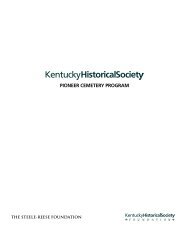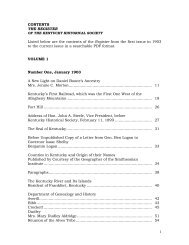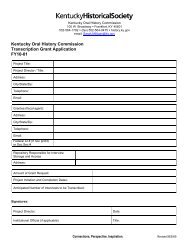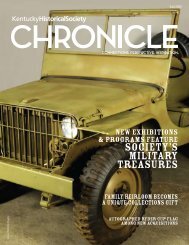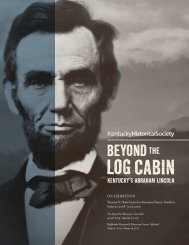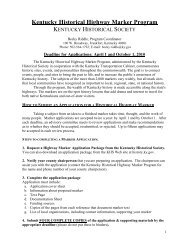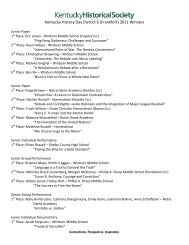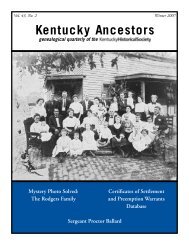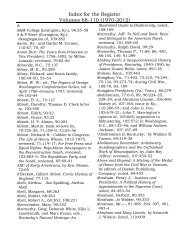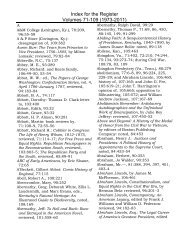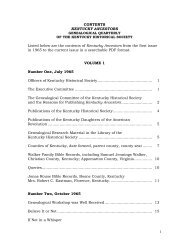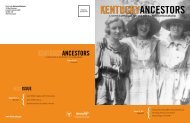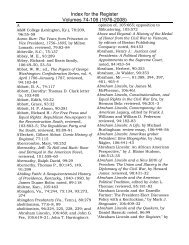kentucky decorative arts treasures - Kentucky Historical Society
kentucky decorative arts treasures - Kentucky Historical Society
kentucky decorative arts treasures - Kentucky Historical Society
Create successful ePaper yourself
Turn your PDF publications into a flip-book with our unique Google optimized e-Paper software.
FEDERALISM<br />
Neoclassical References on<br />
the First Frontier of America<br />
Federal style in <strong>Kentucky</strong> was just one manifestation of<br />
the renewed interest in Greco-Roman classicism that<br />
dominated much of the popular culture of the Anglo-<br />
American world in the 1760-1820 period. Most simply<br />
described, Federalism is an architectural style in which<br />
the body of the object is ornamented with restrained<br />
detail drawn from Renaissance pattern books, most<br />
notably those of the Italian master Antonio Palladio.<br />
The first and perhaps most influential example of<br />
the style in <strong>Kentucky</strong>, Liberty Hall (ca. 1796), was<br />
built in Frankfort by John Brown one of the first<br />
United States senators from the commonwealth.<br />
Brown had spent much time in Philadelphia, the seat<br />
of the Continental Congress and most sophisticated<br />
city in North America. It is thought that he acquired<br />
plans for the house there. Liberty Hall employs a<br />
triangular tympanum-form gable that rises above the<br />
two-floor mass of the house to suggest a temple-form<br />
structure, the center-door entry capped by a tri-partite<br />
“Venetian” window above. On either side of this<br />
temple form, the adjacent sections of the house fall<br />
back just slightly, allowing the suggestion, rather than<br />
the pronouncement, of projection toward the viewer.<br />
Federal form, whether in architecture or the <strong>decorative</strong><br />
<strong>arts</strong>, displays a profound sense of proportionate<br />
mass. This sense of proportion, which may have been<br />
inspired by Masonic notions of the golden mean, is<br />
in keeping with the dynamic symmetry set forth in<br />
the building manuals. Federalism was so popular in<br />
<strong>Kentucky</strong> that it enjoyed a currency that lasted well into<br />
the 1830s. Architectural historian Clay Lancaster refers<br />
to late examples of the style as “Georgian Survival.”<br />
Chaste Taste:<br />
Decorative Motifs in Early <strong>Kentucky</strong> Furniture<br />
(opposite, clockwise from top right)<br />
Liberty Hall, Frankfort <strong>Kentucky</strong>, ca. 1796<br />
Courtesy of Gene Burch.<br />
Daniel Weisiger (1763-1829), Matthew Harris Jouett (1788-1827), ca. 1820<br />
Donated by Lucy A. Breathitt, 2004.56<br />
Lucy Weisiger (1774-1857), Matthew Harris Jouett (1788-1827), ca. 1820<br />
Donated by Lucy A. Breathitt, 2004.56<br />
Sideboard, attributed to Robert Wilson (n.d.), ca. 1815<br />
Donated in memory of Mrs. Mildred P. Martin, 1979.44<br />
“Hamilton Urns, American, 1787-1790,<br />
Adelphi Paper Hangings, Sharon Springs, N.Y.<br />
Early <strong>Kentucky</strong> furniture, “made from richly colored<br />
and marked noted woods” has long been admired.<br />
The same bold massing and subtle detail seen in<br />
the architecture is also present in the furniture and<br />
reflects the rather sophisticated ambitions of the<br />
cabinetmakers themselves. One of the objects in the<br />
KHS collections, a banquet-table end with a projecting<br />
block front and reeded legs, has been attributed to<br />
Porter Clay. Clay announced in the Lexington papers<br />
that he was in “regular correspondence . . . with all<br />
the principal Cabinet Makers both in Philadelphia and<br />
New York.” Purpose-built furniture, notably chests<br />
of drawers and sideboards, were often inlaid with<br />
rare woods in undulating vine motifs, herringbone<br />
banding, and geometric oval and rectilinear panels.<br />
The most outstanding piece of Federal furniture in<br />
KHS collections is a sideboard, donated by Mrs.<br />
Mildred Buster. It is a tripartite piece, with two<br />
serpentine pylons on legs flanking a raised and<br />
serpentine central drawer and bottle-storage space.<br />
The feathery grain of crotch-cherry veneer accents<br />
elongated ovals in the pylon ends. The presence of<br />
herringbone bands above the feet, as well as the bold,<br />
frontal massing of the piece, have raised the possibility<br />
that Robert Wilson, one of the most prominent<br />
cabinetmakers in <strong>Kentucky</strong> during the 1792-1825<br />
period, may have been the maker.




